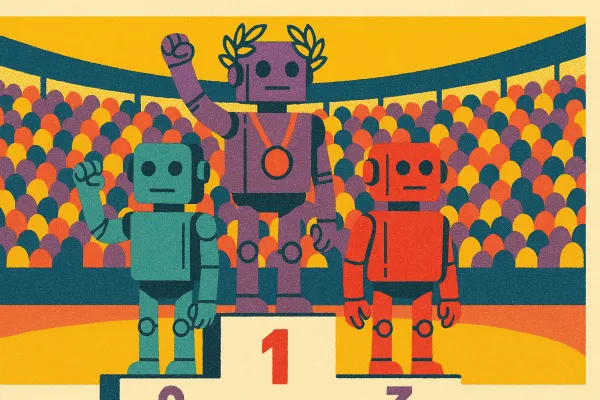
 Details
Details
Once a buzzword, now a backbone — artificial intelligence has become a creative catalyst in native advertising and branded content. From personalised experiences to hyper-efficient content production, AI isn’t just a backend tool anymore. It’s reshaping how brands tell stories, connect with audiences, and scale their impact.
In the world of native advertising, where relevance and resonance are everything, AI offers a new layer of possibility. It powers dynamic tools that let audiences generate their own content. It helps publishers tailor branded narratives to local or niche communities. And it enables marketers to react faster to trends, to data, to culture, while still delivering thoughtful, brand-safe storytelling.
Crucially, the best uses of AI aren’t about replacing creativity; they’re about enhancing it. When paired with editorial insight, cultural understanding, and strategic execution, AI becomes a vehicle for stories that are not only more efficient, but more engaging, more personalised, and often, more imaginative than ever before.
In this article, we’ve collected the 5 best examples of AI in native advertising from 2025 so far, showcasing how technology and creativity can come together to push the boundaries of branded content.
5 Best Examples of Use of AI in Native Advertising 2025 [clickable table of contents]
Best Use of AI Example 1: Apartment Therapy and The Home Depot
Best Use of AI Example 3: Dotdash Meredith and The Campbell’s Company
Best Use of AI Example 4: LOCALiQ/Newsquest Media Group and Multiple Advertisers
Most Common Uses of AI in Native Advertising and Branded Content in 2025
But before you dive into the best examples of use of AI in native advertising in 2025, let's have a quick overview of the most common uses of AI in native advertising and branded content.
At the Native Advertising Institute, we’ve identified seven core types of use of AI that brands are using to connect with audiences, tell stories and scale their impact.
- Personalised content experiences
- Content generation at scale
- Creative asset creation
- Content auditing and optimisation
- Conversational interfaces and chatbots
- Trend forecasting and insights
- Localisation and language adaptation
1. Personalised content experiences
AI powers tools that deliver tailored content from mood board generators and meal planners to interactive quizzes and custom recommendations. These experiences increase user engagement by offering something uniquely relevant to each individual.
2. Content generation at scale
Publishers and brands use AI to quickly generate branded articles, headlines, and social copy, often in real-time or in response to breaking news or seasonal trends. This is especially useful for local or regional targeting at scale.
3. Creative asset creation
AI is used to generate visual elements (e.g. product mockups, virtual accessories, or stylised imagery) when photography budgets are tight or assets don’t exist. It allows for visual storytelling that’s fast, flexible, and fresh.
4. Content auditing and optimisation
Proprietary AI tools analyse existing branded content (especially recipe libraries, how-to articles, or evergreen hubs) to identify gaps, assess performance, and recommend refreshes, ensuring continued relevance to target audiences.
5. Conversational interfaces and chatbots
Brands integrate AI-powered chat experiences to guide users through content journeys, help them discover products, or generate personalised outputs. These chat-based tools bring entertainment, utility, and conversion together.
6. Trend forecasting and insights
AI scans cultural signals, social media, and behavioural data to help brands and content teams stay ahead of emerging trends, informing both creative direction and campaign timing.
7. Localisation and language adaptation
AI translation and tone adjustment tools help adapt branded content for different markets quickly, ensuring consistency while respecting local nuance and brand voice.
5 Examples of Use of AI in Native Advertising [2025 Updated]
Best Use of AI Example 1: Apartment Therapy and The Home Depot
How do you personalise home makeovers for thousands of readers at once? That was the challenge tackled by Apartment Therapy and The Home Depot, resulting in a smart, scalable branded tool that transforms casual inspiration into actionable design.
At the heart of this campaign is a bespoke AI Mood Board Generator. Built to address a common reader pain point — the inability or reluctance to define their interior style — the tool uses conversational AI to deliver curated home decor suggestions from The Home Depot’s vast inventory. Readers could either describe their space using open-ended prompts or click preset style mash-ups like “Traditional, Cozy Chic” or “Antique Jewel Tones and Velvets.” Within minutes, they received a downloadable, shoppable PDF mood board tailored to their aesthetic.
What makes this more than just a tech gimmick is its grounding in editorial insight and native storytelling. Embedded within Apartment Therapy’s Before & After content, the tool met readers in a moment of inspiration, turning passive browsing into meaningful interaction. The results? A 140% engagement rate and a deeply personalised user journey, all while elevating The Home Depot as a go-to for stylish home goods.
This campaign proves that AI doesn’t need to be cold or clinical. When creatively deployed, it can be both personal and playful, and when paired with great editorial and brand alignment, it becomes a standout example of utility-driven native advertising.
Best Use of AI Example 2: Tportal and Samsung
Samsung’s Olympic sponsorship took on a bold, localised twist in Croatia not just celebrating sport, but turning fans into digital creators. Partnering with Tportal, Samsung launched an AI-powered native campaign designed to deepen emotional ties with the brand while educating audiences on the Olympics' global and cultural relevance.
The centrepiece was a bespoke microsite, where readers explored immersive articles blending Olympic history, global unity, and the evolution of technology. But the real hook? A creative contest powered by Samsung Galaxy AI that invited users to design their own Olympic-inspired visual tributes to Croatia’s 2024 athletes.
It was a content strategy with three smart pillars:
- Education through high-quality storytelling
- Engagement via interactive, AI-driven creativity
- Brand affinity by showcasing how Samsung’s tech enhances both sport and everyday experiences
With a clean content experience and distribution across social media, the campaign struck gold in performance metrics:
- 75,000+ article views (66% above target)
- 139 contest submissions (74% above goal)
- 1m 31s average time on page
- 35,000+ reached on social (133% above forecast)
More than just a showcase of innovation, the campaign proved that gamified interaction drives deeper engagement, and that audiences crave active, participatory brand experiences, especially when powered by AI and wrapped in culturally resonant storytelling.
Samsung didn’t just talk tech. It handed the tools to its audience and, in doing so, turned Olympic spectators into creative brand advocates.
Best Use of AI Example 3: Dotdash Meredith and The Campbell’s Company
In a bold play for Gen Z and Millennial mealtime mindshare, The Campbell’s Company teamed up with Dotdash Meredith’s The Foundry and Spark Foundry to reinvent weeknight cooking with the help of artificial intelligence.
The result? Dinner Inspirations – a consumer-facing AI tool hosted on Allrecipes.com that doesn’t just suggest recipes, but generates fully customised, chat-based meal ideas in response to user prompts. Whether you’re a busy parent looking for quick comfort food or a foodie chasing flavour, the AI offers up meal suggestions centred on Campbell’s iconic Condensed soups complete with influencer tips and easy-to-shop ingredients.
But this was more than just a flashy front-end. Behind the scenes, Dotdash Meredith also deployed a proprietary AI-powered content audit across Campbell’s recipe ecosystem, analysing existing content from Campbell’s Condensed, Pacific Foods, and Pace. Recipes that didn’t meet the mark were reworked by human editors ensuring that every dish felt relevant, appealing, and Gen Z-ready.
The results spoke volumes:
- 80K+ page views and nearly 20K engagements in just two months
- 570%+ above benchmark in time spent with the tool
- Significant CTR uplift to refreshed recipes, especially among younger, health-conscious consumers
With AI driving both consumer experience and content optimisation, this campaign didn’t just meet modern dinner needs — it anticipated them. A shining example of how brands can combine tech, editorial, and behavioural insight to stay top-of-mind, top-of-feed, and top-of-plate.
Best Use of AI Example 4: LOCALiQ/Newsquest Media Group and Multiple Advertisers
Can AI unlock native advertising for local businesses at scale — without losing the nuance of local storytelling? LOCALiQ and Newsquest Media Group say yes.
In 2024, the publisher group behind 200+ UK news sites transformed its internal AI editorial tools into a scalable, branded content engine. The aim: to help small and medium-sized businesses (SMEs) across the UK tap into the power of native advertising affordably, efficiently, and with local relevance.
The system works like this: Newsquest’s human editors identify timely, local, or seasonal stories. AI then helps turn these news moments into branded content opportunities – fast. From "top tips to secure your home in storm x" to rewriting client press releases as reader-friendly sponsored stories, the output blends editorial integrity with commercial strategy.
All articles are drafted with style and fact-checking tools built in, ensuring consistency and trust across Newsquest platforms. Each story is reviewed and refined in collaboration with the advertiser before being published as native content on relevant local news sites.
The results are promising:
- 100+ AI-assisted branded articles produced since December 2024
- 8 confirmed sales, generating nearly £8,000 in early revenue
- Performance on par with traditional editorial in time-on-page and click-through rates
By embedding branded content into trusted local news environments, and using AI to remove traditional production bottlenecks, Newsquest is democratising native advertising for small businesses. The initiative offers a glimpse of how AI can augment editorial instincts rather than replace them, while turning local media into a smarter, faster, more accessible content platform for advertisers.
Best Use of AI Example 5: ELLE Sweden and Levi’s
How do you make a global fashion campaign feel personal, local, and irresistible all on a modest budget? Levi’s and Aller Media’s Creative Studio answered with Cowboy Core, a bold native campaign for ELLE Sweden that merged trend-savvy storytelling with practical AI innovation.
Targeting ELLE’s trend-conscious women aged 25–30, the campaign had a clear mission: position Levi’s as an iconic, timeless brand with a place in every wardrobe. But when creative constraints left them without enough real products for a planned fashion spread, the team pivoted and used AI to generate missing fashion items, visual assets, and styling elements tailored specifically to ELLE’s audience.
The result: a seamless, stylish multi-platform campaign spanning print, digital, social, and video.
- On ELLE.se, fashion editor Amie Chorr spotlighted western-inspired styling tips in an interview-led feature.
- On social media, a product carousel extended the visual inspiration, drawing over 1.5M impressions.
- In print, a denim-focused editorial page brought summer styling to life elevated by AI-designed accessories.
- And through ELLE’s branded video format “My Look”, editor Josefine Kanth showed off on-trend Levi’s outfits in action.
The results over-delivered across the board:
- +20% unique page views on ELLE.se
- +78% over-performance on SoMe impressions
- +8% over-delivery on video campaign KPIs
More than a campaign, Cowboy Core was a masterclass in how to use AI not to replace creativity, but to amplify it. Through close editorial collaboration and smart tech deployment, Levi’s didn’t just follow a trend, it helped define one, all while reinforcing the brand’s place in the modern Swedish wardrobe.



